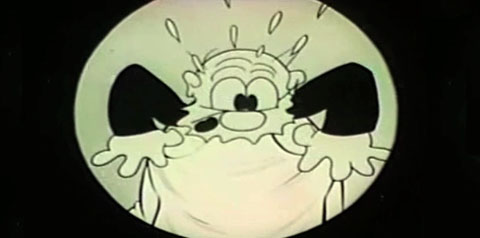

Cartoon Brew TV #3: Dinner Time by Paul Terry and John Foster
(Alternate commentary-free version: This link will allow you to watch the original cartoon without audio commentary)
Welcome to the first in our series of Cartoon Brew TV’s “Brew Vaults.” Every three weeks we’re presenting an animated short, movie trailer, vintage TV commercial or some other cartoon rarity and offering an exclusive audio track commentary about its production, historical significance and the artists who made these films. Animation historian Jerry Beck and other guests will provide the commentaries.
The first pick from the “Brew Vaults” is one of the earliest sound cartoons ever released. Dinner Time (1928) is perhaps the most significant cartoon in animation history that no one has ever seen. It was one of the few synchronized sound cartoons produced before (though released after) Disney’s Steamboat Willie. It played a small but pivotal part in Walt Disney’s creation of his first Mickey Mouse sound cartoon. It was this film, shown to Walt in New York on the cusp of recording his track for Steamboat Willie, that gave him the confidence to press on with his plans.
Dinner Time was an entry in Paul Terry’s popular series of the era, Aesop’s Film Fables, produced by Amadee J. Van Beuren, and released through RKO Pathé. During the 1920s, Terry produced one Fables cartoon each week through his New York based Fables Studio, and Walt Disney was known to be quite fond of them. But when sound came in, Terry had little interest in adding music, voices or effects to the cartoons, and this led to a disagreement between the animator and his producer. Terry left Van Beuren the following year to start his own company, Terrytoons.
Dinner Time is not a particularly good cartoon. Walt Disney himself called it “one of the rottenest Fables I believe that I ever saw. And I should know, because I have seen almost all of them!” The film, and Walt’s reaction to it, has been noted in every major biography of Disney (Michael Barrier, Bob Thomas, Neal Gabler), yet no one has really seen it in eighty years.
It turns out that Disney was right. The soundtrack is “rotten” and the animation quite primitive (especially compared to Fleischer’s KoKo cartoons or Messmer’s Felix cartoons made the same year), but the early Paul Terry cartoons have an old-school hand-drawn charm that all the technical innovations to come can’t begin to match. There’s an air of chaos in Terry’s cartoon universe, with cats chasing birds, dogs chasing bones, farmers chasing hounds, and plot and character nowhere in sight. And yet, the Fables were fun, popular and a mainstay of the silent era and early days of sound. Terry ultimately had the last laugh on his old boss, Van Beuren. His rival Terrytoons studio thrived for four decades (Van Beuren’s studio closed in 1936 with his passing), and Terry himself never really left Dinner Time behind–he lifted animation from this short to pad his 1931 Terrytoon release, Jazz Mad.
UPDATE: Additional research since the time we first post this cartoon has turned up the missing coda or “Moral”:
Aesop Says: “There is a real need for a tonic for people whose heads are bald on thew inside”
We’d like to thank Mark Kausler for his participation on the audio commentary and locating the source films; Randall Kaplan for editing and restoration services; and Michael Geisler for recording the audio commentary.
